History of lacrosse
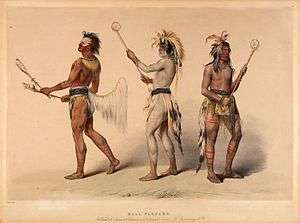
Lacrosse has its origins in a tribal game played by eastern Woodlands Native Americans and by some Plains Indians tribes in what is now Canada. The game was extensively modified by European immigrants to North America to create its current collegiate and professional form. There were hundreds of native men playing a ball game with sticks.The game began with the ball being tossed into the air and the two sides rushing to catch it. Because of the large number of players involved, these games generally tended to involve a huge mob of players swarming the ball and slowly moving across the field. Passing the ball was thought of as a trick, and it was seen as cowardly to dodge an opponent.[2]
Native American game

Modern day lacrosse descends from and resembles games played by various Native American communities. These include games called dehuntshigwa'es in Onondaga ("men hit a rounded object"), da-nah-wah'uwsdi in Eastern Cherokee ("little war"), begadwe in Mohawk language ("little brother of war"), baaga`adowe in Ojibwe ("bump hips")[3] and kabucha in Choctaw.[4]
Lacrosse is one of the oldest team sports in North America. There is evidence that a version of lacrosse originated in what is now Canada as early as the 17th century.[5][6] Native American lacrosse was played throughout modern Canada, but was most popular around the Great Lakes, Mid-Atlantic seaboard, and American South.
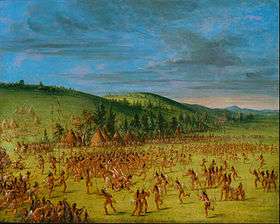
Traditional lacrosse games were sometimes major events that could last several days. As many as 100 to 1,000 men from opposing villages or tribes would participate. The games were played in open plains located between the two villages, and the goals could range from 500 yards (460 m) to 6 miles (9.7 km) apart.[7]
Rules for these games were decided on the day before. Generally there was no out-of-bounds, and the ball could not be touched with the hands. The goals would be selected as large rocks or trees; in later years wooden posts were used. Playing time was often from sunup until sundown.
There are traditionally three areas of scoring on the stickball pole. There is a mark, about chest high on the pole, and when scored above, awards one point. Contact below that point is not scored. The top half of the pole, well above arms reach, is worth two points when hit. The very top of the pole, usually embellished with a large figure of a fish, is worth three points. In recreational games, scoring is loosely kept, most times by the audience or a few players. Games typically reach around twenty points before concluding.
The game began with the ball being tossed into the air and the two sides rushing to catch it. Because of the large number of players involved, these games generally tended to involve a huge mob of players swarming the ball and slowly moving across the field. Passing the ball was thought of as a trick, and it was seen as cowardly to dodge an opponent.[2]
The medicine men acted as coaches, and the women of the tribe were usually limited to serving refreshments to the players.[8] (There was also a women's version of lacrosse called amtahcha, which used much shorter sticks with larger heads.[9])
Lacrosse traditionally had many different purposes. Some games were played to settle intertribal disputes. This function was essential to keeping the Six Nations of the Iroquois together. Lacrosse was also played to toughen young warriors for combat, for recreation, as part of festivals, and for the bets involved. Finally, lacrosse was played for religious reasons: "for the pleasure of the Creator" and to collectively pray for something.[10]
Rituals
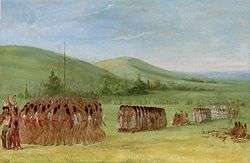
Pre-game rituals were very similar to rituals associated with war. Players would decorate their bodies with paint and charcoal. Players also decorated their sticks or stick racks with objects representing qualities desired in the game. Strict taboos were held on what players could eat before a game, and the medicine man performed rituals to prepare players and their sticks. The night before a game, players wore ceremonial regalia and held a special dance. Sacrifices were held, and sacred expressions were yelled to intimidate opponents.[11]
On the day of the game, teams walked to the field and were slowed by constant rituals. One ceremony was "going to water," in which players dunked their sticks in water and the shaman gave a spiritual and strategic pep talk. Sometimes players would receive ceremonial scratches on their arms or torso.[12]
Before the game, every player was required to place a wager. Items such as handkerchiefs, knives, trinkets, horses, and even wives and children would be at stake. The bets would be displayed on a rack near the spectators, and items would be awarded proportionally to the winner of each quarter.[13][14]
When the game was over another ceremonial dance took place, along with a large feast for the hungry players.
Equipment
Some early lacrosse balls were made out of wood. Others were made of deerskin stuffed with hair.[15] They were typically three inches in diameter.[16]
The first lacrosse sticks were essentially giant wooden spoons with no netting.[17] A more advanced type had one end bent into a 4 to 5-inch (130 mm) diameter circle, which was filled with netting.[18] This netting was made of wattup or deer sinew.[19] The most recent Native American sticks use a U-shape instead of a circle.
These sticks were bent into shape after being softened through steaming, and lengths typically ranged from 2 to 5 feet (1.5 m).[18] Lacrosse sticks often had elaborate carvings on them intended to help players in the game.[14] Lacrosse sticks were so treasured that many players requested to be buried with their stick beside them.[14]
Some versions of lacrosse used unusual stick designs. In the St. Lawrence Valley a version was played in which the head took up two thirds of the stick. In the Southwestern United States a double-stick version was played with sticks about two and a half feet long.[20]
No protective equipment was worn in traditional lacrosse.[21]
European involvement
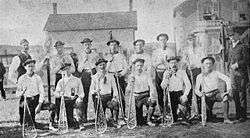
The first westerners to encounter lacrosse were French Jesuit missionaries in the St. Lawrence Valley. During the 1630s, they witnessed the game and condemned it. They were opposed to lacrosse because it was violent, betting was involved, and it was part of the religion they sought to eradicate.[21]
One missionary, Jean de Brébeuf, was the first to write about lacrosse and thus gave it its name. He described the Huron Indians playing in 1636. Some say the name originated from the French term for field hockey, le jeu de la crosse.[22] Others suggest that it was named after the crosier, a staff carried by bishops.[7]
Despite Jesuit opposition, many other European colonists were intrigued by lacrosse. Betting on games became common, and around 1740 many French colonists were taking up the game. However, it is widely believed they could not match the skill of the Native Americans.[22]
James Smith described in some detail a game being played in 1757 by his fellow tribe members "wherein they used a wooden ball, about three inches diameter, and the instrument they moved it with was a strong staff about five feet long, with a hoop net on the end of it, large enough to contain the ball."[23]
In 1763, Ojibwas used a lacrosse game to capture Fort Michilimackinac (now Mackinac). Natives invited the fort's British troops to watch a lacrosse game. The players gradually worked their way close to the gates, and then rushed into the fort and carried out a general massacre.[24]
In 1805 during an expedition up the Mississippi River, U.S. army officer Lt. Zebulon Pike observed a group of young Sioux and Winnebago men playing this game, or one resembling it, near the east bank of the river, in what is now west-central Wisconsin. He named the region "Prairie La Crosse", which in turn inspired the name of both the Wisconsin county and its principal city in that region.[25] Today, two statues in the city of La Crosse (one downtown, the other along southbound US Highway 53 entering the city from the north) commemorate the game observed by Pike.
In 1834 a team of Caughnawaga Indians demonstrated lacrosse in Montreal. Although response to the demonstrations was not overwhelming, interest in lacrosse steadily grew in Canada.[26]
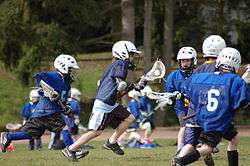
In 1856, William George Beers, a Canadian dentist, founded Montreal Lacrosse Club. He codified the game in 1867 to shorten the length of each game, reduce the number of players, use a redesigned stick, and use a rubber ball. The first game played under Beers' rules was at Upper Canada College in 1867. During the 1860s lacrosse became Canada's national game. The first overseas exhibition games were played in 1867. In 1876, Queen Victoria witnessed an exhibition game and was impressed, saying "The game is very pretty to watch." Her endorsement was enough for many English girls' schools to adopt the sport in the 1890s.[27] The Mohawk Lacrosse Club in Troy, New York became the first organized club in the United States.
As lacrosse grew, opposition to its violent aspects was a major obstacle. The game was banned in some areas when, in 1900, Choctaw Indians attached lead weights to their sticks to use them as skull-crackers.[26]
By the 20th century, many high schools, colleges and universities had adopted lacrosse as a league sport. Lacrosse became an Olympic sport for the 1904 and 1908 Summer Olympics, but was then dropped as an official sport. After 1908, lacrosse was a sport in the World Games.
In the 1930s, an indoor version of the game, box lacrosse, was introduced in Canada. It quickly became the dominant form of the sport in Canada, in part due to the severe winter weather that limited outdoor play.
Minor leagues developed for box lacrosse and college lacrosse. Two professional leagues also were created: In 1987 the Eagle Pro Box Lacrosse League was founded; it eventually became the Major Indoor Lacrosse League, and then the National Lacrosse League (NLL). In the summer of 2001, a professional field lacrosse league, known as Major League Lacrosse (MLL), was inaugurated.
See also
References
- ↑ Stancari, Lou (2009-11-23). "Further information at NMAI (scroll down)". Blog.photography.si.edu. Retrieved 2012-05-30.
- 1 2 Liss, Howard. Lacrosse (Funk & Wagnalls, 1970) pg 10.
- ↑ "Freelang Ojibwe Dictionary". Retrieved 2007-03-30.
- ↑ Haag, Marcia; Henry Millis (2001). Choctaw Language & Culture: Chahta Anumpa. Norman OK: University of Oklahoma Press. p. 368. ISBN 978-0-8061-3339-3.
- ↑ Vennum, Thomas. American Indian Lacrosse: Little Brother of War. (Smithsonian Institution, 1994) SBN 978-1560983026.
- ↑ Liss, Howard. Lacrosse (Funk & Wagnalls, 1970) pg 13.
- 1 2 "Lacrosse History". STX. Archived from the original on 2007-05-24. Retrieved 2007-02-24.
- ↑ Culin, Stewart. Games of the North American Indians (Dover Publications, 1907) ISBN 978-0486231259. pg 580, 607.
- ↑ Culin, Stewart. Games of the North American Indians (Dover Publications, 1907) ISBN 978-0486231259. pg 596.
- ↑ Rock, Tom (November–December 2002). "More Than a Game". Lacrosse Magazine. US Lacrosse. Archived from the original on 2007-08-22. Retrieved 2007-03-18.
- ↑ Culin, Stewart. Games of the North American Indians (Dover Publications, 1907) ISBN 978-0486231259. pg 563-577.
- ↑ Culin, Stewart. Games of the North American Indians (Dover Publications, 1907) ISBN 978-0486231259. pg 580.
- ↑ Culin, Stewart. Games of the North American Indians (Dover Publications, 1907) ISBN 978-0486231259. pg 584.
- 1 2 3 Conover, Adele. "Little Brother of War." Smithsonian Dec 1997: pg 32.
- ↑ "Living Traditions | Lacrosse". Museevirtuel.ca. Retrieved 2012-05-30.
- ↑ Culin, Stewart.hi Games of the North American Indians (Dover Publications, 1907) ISBN 978-0486231259. pg 563.
- ↑ Culin, Stewart. Games of the North American Indians (Dover Publications, 1907) ISBN 978-0486231259. pg 594.
- 1 2 Culin, Stewart. Games of the North American Indians (Dover Publications, 1907) ISBN 978-0486231259. pg 566.
- ↑ Liss, Howard. Lacrosse (Funk & Wagnalls, 1970) pg 9.
- ↑ Vennum, Thomas (1994). American Indian Lacrosse: Little Brother of War. Smithsonian Institution. ISBN 9781560983026.
- 1 2 "Lacrosse: E-Lacrosse Lacrosse Links and Lacrosse Sources". E-lacrosse.com. Retrieved 2012-05-30.
- 1 2 "Lacrosse: E-Lacrosse Lacrosse History, Links and Sources". E-lacrosse.com. Retrieved 2012-05-30.
- ↑ https://archive.org/details/accountofremarka00smit
- ↑ Hodge, Frederick Webb. Handbook of American Indians North of Mexico, in two parts, Part 1; Washington, Government Printing Office. 1907. PAGE 127.
- ↑ Writ in Remembrance: 100 Years of LaCrosse Area History: Lacrossewa.us
- 1 2 "History of Native American Lacrosse". Uslacrosse.org. Retrieved 2012-05-30.
- ↑ "Jonathan Thompson explains the kit, the body armour and the bloody Native American history of lacrosse". Highbeam.com. 2001-10-14. Retrieved 2012-05-30.
Further reading
- Arnold, Philip P. (2012). The Gift of Sports: Indigenous Ceremonial Dimensions of the Games We Love. San Diego, CA: Cognella. ISBN 978-1-62131-047-1.
- Beers, William George (1869), Lacrosse: the national game of Canada, Dawson Brothers
- Culin, Stewart (1975). Games of the North American Indians. Courier Dover Publications. pp. 846 pages. ISBN 0486231259. Retrieved 2012-05-30.
- Fisher, Donald M (2002), Lacrosse: a history of the game, Johns Hopkins University Press, ISBN 0801869382
- Vennum, Thomas; Vennum, Thomas Jr (2008). American Indian Lacrosse: Little Brother of War. JHU Press. ISBN 080188764X.
- Vennum, Thomas (2007), Lacrosse legends of the first Americans, Johns Hopkins University Press, ISBN 9780801886287
- Yeager, John M (2006), Our game: the character and culture of Lacrosse, Dude Pub, ISBN 1887943994
External links
- Onondaga: The Lacrosse Stick Makers
 Media related to History of lacrosse at Wikimedia Commons
Media related to History of lacrosse at Wikimedia Commons Works related to Lacrosse: The National Game of Canada at Wikisource
Works related to Lacrosse: The National Game of Canada at Wikisource


